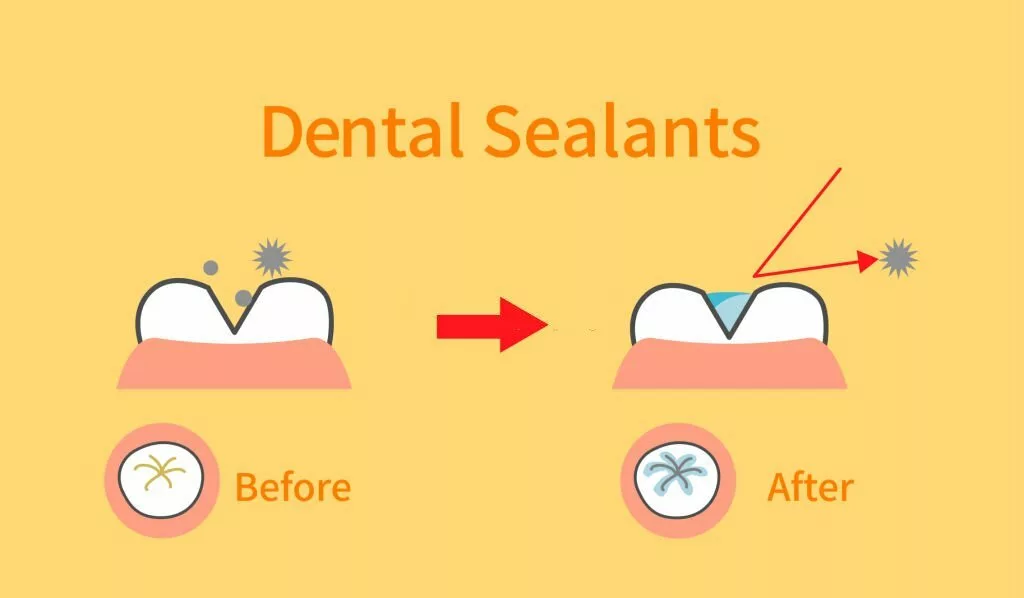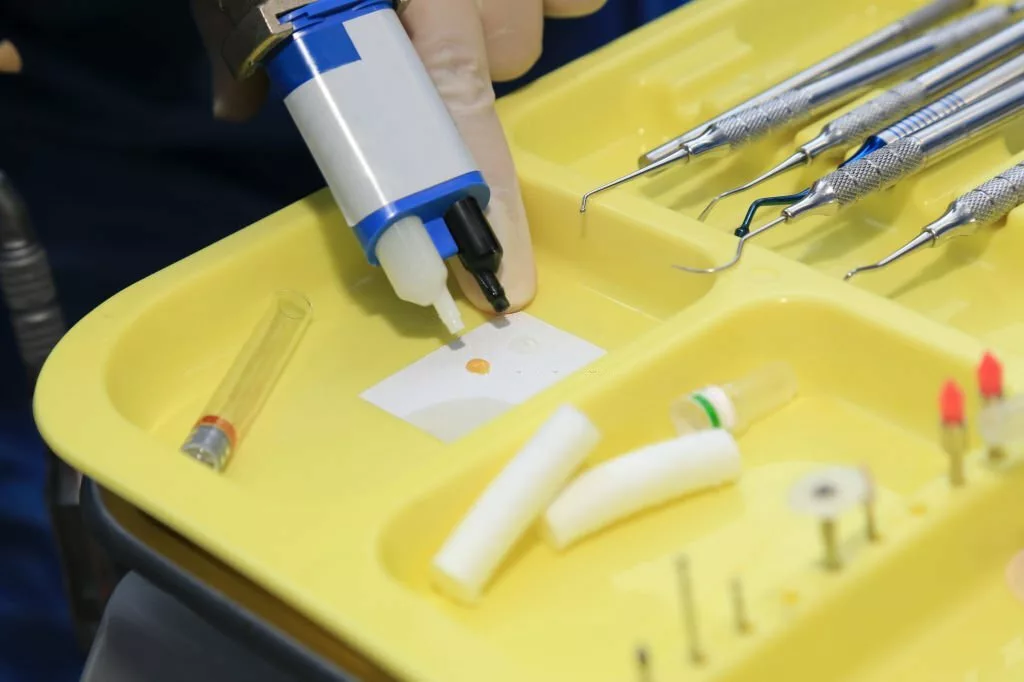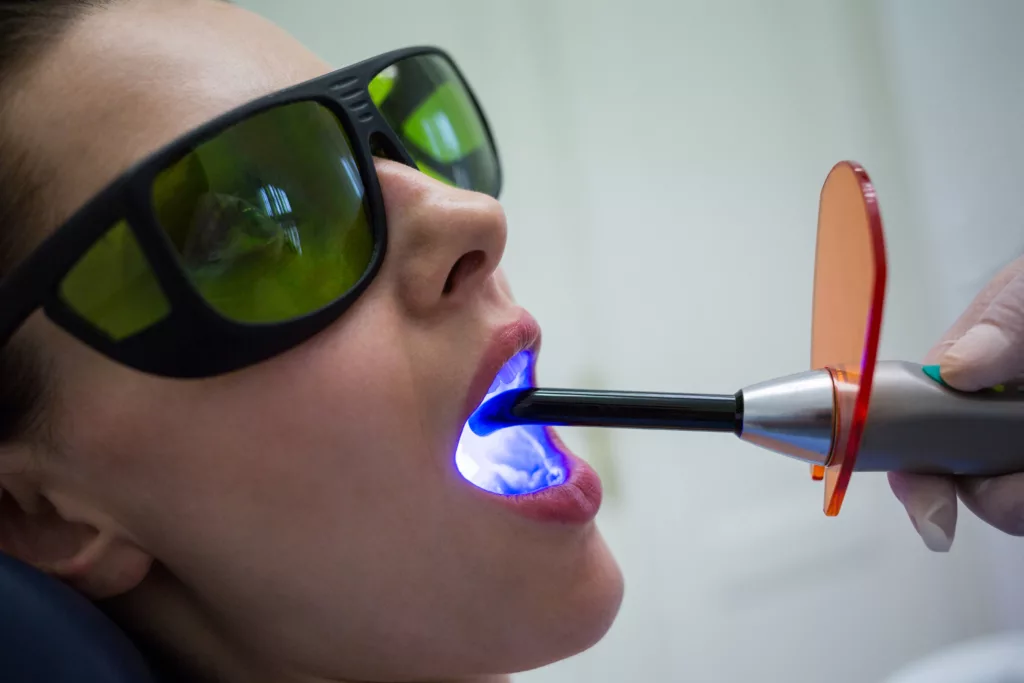In the oral cavity, teeth break the larger food particles into smaller ones to make working of digestive enzymes easier and help the body digest the food easily and absorb nutrients. However, teeth are not immune to the relentless actions of bacteria, particularly on surfaces prone to caries. This is where dental sealants step in, offering protection to these vulnerable tooth surfaces. While diligent brushing can effectively clean most tooth surfaces, certain areas remain beyond the toothbrush’s reach, such as the spaces between adjacent teeth and the intricate pits and fissures on chewing surfaces. These concealed areas provide ideal breeding grounds for bacteria and accumulate food debris. 1Ahovuo-Saloranta, A., Forss, H., Walsh, T., Nordblad, A., Mäkelä, M., & Worthington, H. V. (2017). Pit and fissure sealants for preventing dental decay in permanent teeth. The Cochrane database of systematic reviews, 7(7), CD001830. https://doi.org/10.1002/14651858.CD001830.pub5.
What are Dental Sealants?
Dental sealants, made from glass ionomer or polyacid resin materials, are a form of dental restoration strategically applied as a thin layer to the less exposed or deep surfaces of teeth, primarily as a preventive measure against caries. These sealants play a pivotal role in sealing and safeguarding these surfaces.2Oong, E. M., Griffin, S. O., Kohn, W. G., Gooch, B. F., & Caufield, P. W. (2008). The effect of dental sealants on bacteria levels in caries lesions: a review of the evidence. Journal of the American Dental Association (1939), 139(3), 271–358. https://doi.org/10.14219/jada.archive.2008.0156They prevent the accumulation of food debris within these concealed areas and inhibit the harmful actions of bacteria on trapped food particles. Hence, saving the tooth from the carious action3Colombo, S., & Paglia, L. (2018). Dental Sealants. Part 1: Prevention First. European journal of pediatric dentistry, 19(1), 80–82. https://doi.org/10.23804/ejpd.2018.19.01.15.

Dental Sealant Vs. Filling
Fillings or tooth restorations are dental materials that are applied to the carious tooth to restore its shape and function. For example, when a tooth gets damaged by carious activity or one or more of its walls gets decayed, the dentist removes the caries lesion via proper instrumentation and places a dental filling to get the normal tooth form 4Mark A. M. (2016). Dental sealants. Journal of the American Dental Association (1939), 147(8), 692. https://doi.org/10.1016/j.adaj.2016.05.007.
However, dental sealants involve applying a thin layer of plastic-containing material as a preventive measure before any damage to the tooth occurs. The application of dental sealants takes place prior to the onset of a carious lesion. These sealants help decrease the risk of caries lesions by sealing susceptible areas. On the other hand, fillings are used to improve the tooth’s aesthetics and partially restore its masticatory function.
Indications for Dental Sealants
The following are the clinical indications for dental sealants:
- Early Intervention for High Caries Risk: For patients at a high risk of developing cavities in their primary (milk) teeth, it is advisable to recommend sealants. Additionally, apply sealants to their permanent teeth as soon as they emerge.
- Inadequate Oral Hygiene: Sealants are beneficial for patients who struggle with maintaining proper oral hygiene practices to provide an extra layer of protection against tooth decay.
- Orthodontic Patients: Individuals undergoing orthodontic treatments, such as braces, can benefit from sealants. The presence of orthodontic appliances can make it challenging to clean teeth thoroughly, making sealants a valuable preventive measure.
- High Sugar Diet: Patients with a diet high in sugars and carbohydrates are at an increased risk of tooth decay. Sealants offer an additional defense against cavities in such cases.
- Low Blood Fluoride Levels: For patients with low levels of fluoride in their bloodstream, sealants serve as a proactive measure to strengthen and protect tooth enamel, reducing the risk of decay.
Materials used as Dental Sealants
Belonging to the category of modern dental materials, dental sealants are composed of materials that are tooth colored and maintain chemical bonding with the tooth surface. Their bond with the tooth surface determines the success or failure of the application5Colombo, S., & Beretta, M. (2018). Dental Sealants Part 3: Which material? Efficiency and effectiveness. European journal of paediatric dentistry, 19(3), 247–249. https://doi.org/10.23804/ejpd.2018.19.03.15. The two most common materials used as dental sealants are:
Glass Ionomer Cements-GIC:
This material forms a direct chemical bond with the tooth surface. It has the inherent property of releasing fluoride in the oral cavity. Fluoride keeps a check on bacterial growth and makes tooth structure resistant to caries and bacterial action6Ng, T. C., Chu, C. H., & Yu, O. Y. (2023). A concise review of dental sealants in caries management. Frontiers in oral health, 4, 1180405. https://doi.org/10.3389/froh.2023.1180405. This type of sealant does not last longer as it dries out readily and cannot bear the masticatory stress.

Resin-Based Sealants:
Resin-based sealants are the most commonly used type. They are composed of a plastic-like material (composite resin) and a bonding agent that bonds the dental sealant material to the tooth. This can endure the heavy forces of mastication in the posterior teeth. Although this material doesn’t release fluoride in greater quantity, it has a greater duration because of its higher tensile strength.
Application Procedure for Dental Sealant
The application of dental sealant involves the following steps:
Preparation of Tooth Surface:
The dentist or dental hygienist will start by cleaning and drying the tooth’s surface that will receive the sealant. This ensures that no debris or moisture interferes with the bonding process.
Drying:
Dry the cleaned tooth surface with the help of cotton pellets to remove excessive moisture, which hampers the bonding between the tooth surface and sealant material.
Moisture Control:
It is crucial to isolate the tooth from the rest of the oral cavity to maintain the dry field because the presence of moisture in the working field will affect the efficacy of the procedure.
Etching:
To enhance the sealant’s adhesion to the tooth, the dentist may apply an etching solution (usually phosphoric acid) to the tooth’s surface. This solution roughens the enamel slightly, creating a better surface for the sealant to bond to. After a brief period, the etching solution is rinsed off, and the tooth is dried again.
Application of Bonding Agent:
The next step is to apply a bonding agent to the etched tooth surface. The bonding agent acts as an intermediary layer between the tooth and the sealant, improving the adhesion of the sealant to the enamel.
Application of Dental Sealants:
The dentist will then apply the dental sealant material onto the prepared tooth surface. The sealant is often in a liquid or gel form and can be clear or tooth-colored. It’s carefully spread over the grooves and fissures of the tooth. It is important to make sure that a thin covering is placed so the patient does not feel discomfort after the procedure.
Curing of Sealant:
In this step, the dentist cures the sealing material with the help of curing light. Curing is done for almost 15 seconds from different angles. This light activates a chemical reaction within these materials, causing them to solidify and bond securely to the tooth.

Assessment:
After the sealant has hardened, the dentist will check its placement and make any necessary adjustments, ensuring that the sealant covers all the grooves and fissures on the tooth’s surface. The dentist will ask the patient to bite down and check the patient’s bite to ensure that the sealant does not interfere with their natural bite pattern.
Cleaning and Polishing:
The next step is to clean the tooth surface to remove excess material and allow the patient to rinse7Muehleis P. (2011). Dental sealants. Journal of the American Dental Association (1939), 142(1), 14–16. https://doi.org/10.14219/jada.archive.2011.0004. If needed, the dentist may polish the sealant to ensure a smooth and comfortable fit with the opposing teeth
What Problems Can Occur while Applying Dental Sealants?
The most common problem occurring during the application of dental sealants is the failure of the dentist to maintain a dry and isolated field. Moisture appears over the working area and hampers the effective bonding of material with tooth surface. Similarly, in some cases, the weak bond of the sealant with the tooth allows partial displacement and complete loss of sealant material, leaving the permanent tooth exposed to the action of bacteria8Ramamurthy, P., Rath, A., Sidhu, P., Fernandes, B., Nettem, S., Fee, P. A., Zaror, C., & Walsh, T. (2022). Sealants for preventing dental caries in primary teeth. The Cochrane database of systematic reviews, 2(2), CD012981. https://doi.org/10.1002/14651858.CD012981.pub2. Improper curing of the material doesn’t allow the sealant to get the ideal consistency and bond with the tooth surface. Properly applying the sealant while considering all instructions and precautions can help avoid all such problems.
Are there any Side Effects of Dental Sealants?
Dental sealants are ideal protective material for teeth, but they still pose some problems:
Allergic Reaction:
Some patients develop severe allergic reactions to the ingredients of dental sealant. To prevent such mishaps, it is advisable to gather a complete medical history before treatment.
Leakage:
Improper application of dental sealant allows the saliva to penetrate under it and cause carious lesions. Such carious lesions are difficult to detect.
Sealant Wear and Tear:
Over time, dental sealants can wear down, chip, or crack. Therefore, regular dental check-ups are necessary to monitor the condition of the sealants. If damage is detected, they may need to be repaired or replaced.
Sensitivity and Discomfort:
The extra layer of the material on the tooth surface can cause discomfort to the patient. Additionally, Some individuals may experience temporary tooth sensitivity after getting sealants. This sensitivity typically resolves on its own within a short time.
It is important to note that the risk of experiencing adverse effects from dental sealants is minimal. On the other hand, the benefits of sealants in preventing cavities and promoting oral health typically far outweigh any potential side effects. If you have concerns or questions about dental sealants, it’s advisable to discuss them with your dentist, who can provide personalized guidance based on your specific dental needs and circumstances.
How Long Will Sealants Last?
Normally, a good quality sealant, with proper application, will last for almost ten years. During this time, it saves the tooth from carious attack by minimizing the caries-prone surface. However, some dentists recommend the replacement of dental sealants every four years to maintain the efficacy of sealants and compensate for the wear off of the sealant material due to masticatory forces.
How is the Dental Sealant Removed?
If the dental sealants become damaged, displaced, or cracked, it is advisable to remove the old ones and install new sealants. The procedure of removal includes the use of a dental drill or laser for precision working. This drill removes the faulty materials and exposes an intact tooth surface.
To sum it up, dental sealants provide the best tooth-protective layer against bacterial action and food debris accumulation. Proper application enhances the benefits of dental sealants to manifolds.
Refrences
- 1Ahovuo-Saloranta, A., Forss, H., Walsh, T., Nordblad, A., Mäkelä, M., & Worthington, H. V. (2017). Pit and fissure sealants for preventing dental decay in permanent teeth. The Cochrane database of systematic reviews, 7(7), CD001830. https://doi.org/10.1002/14651858.CD001830.pub5
- 2Oong, E. M., Griffin, S. O., Kohn, W. G., Gooch, B. F., & Caufield, P. W. (2008). The effect of dental sealants on bacteria levels in caries lesions: a review of the evidence. Journal of the American Dental Association (1939), 139(3), 271–358. https://doi.org/10.14219/jada.archive.2008.0156
- 3Colombo, S., & Paglia, L. (2018). Dental Sealants. Part 1: Prevention First. European journal of pediatric dentistry, 19(1), 80–82. https://doi.org/10.23804/ejpd.2018.19.01.15
- 4Mark A. M. (2016). Dental sealants. Journal of the American Dental Association (1939), 147(8), 692. https://doi.org/10.1016/j.adaj.2016.05.007
- 5Colombo, S., & Beretta, M. (2018). Dental Sealants Part 3: Which material? Efficiency and effectiveness. European journal of paediatric dentistry, 19(3), 247–249. https://doi.org/10.23804/ejpd.2018.19.03.15
- 6Ng, T. C., Chu, C. H., & Yu, O. Y. (2023). A concise review of dental sealants in caries management. Frontiers in oral health, 4, 1180405. https://doi.org/10.3389/froh.2023.1180405
- 7Muehleis P. (2011). Dental sealants. Journal of the American Dental Association (1939), 142(1), 14–16. https://doi.org/10.14219/jada.archive.2011.0004
- 8Ramamurthy, P., Rath, A., Sidhu, P., Fernandes, B., Nettem, S., Fee, P. A., Zaror, C., & Walsh, T. (2022). Sealants for preventing dental caries in primary teeth. The Cochrane database of systematic reviews, 2(2), CD012981. https://doi.org/10.1002/14651858.CD012981.pub2

